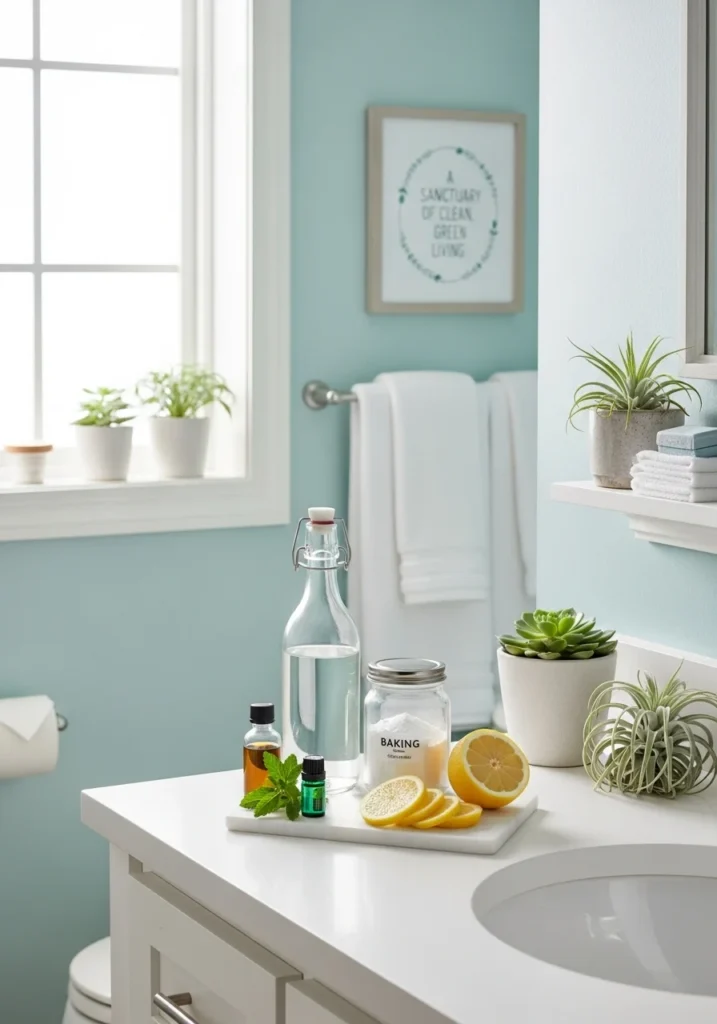Introduction
A clean bathroom is more than just a visual requirement; it plays a crucial role in maintaining overall hygiene, promoting relaxation, and ensuring a healthier home environment. However, traditional cleaning products often contain synthetic chemicals that can be harmful to your skin, irritate your respiratory system, and even pollute the water supply. The good news is that you don’t have to rely on these harsh chemicals to keep your bathroom sparkling clean.
In fact, making the switch to natural, eco-friendly bathroom cleaning solutions is simpler and more affordable than you might think. Many everyday items you already have in your pantry or cleaning cabinet can work wonders in cleaning, disinfecting, and deodorizing your bathroom. Ingredients such as vinegar, baking soda, essential oils, and lemon juice not only offer a safer alternative but are also often more effective than their commercial counterparts.
Switching to natural cleaning methods isn’t just about avoiding harsh chemicals; it’s about embracing a sustainable lifestyle that prioritizes both personal and environmental well-being. By using ingredients that are non-toxic and biodegradable, you’re doing your part to reduce pollution, protect wildlife, and contribute to a healthier planet.
Whether you’re dealing with soap scum on the shower walls, mold and mildew in the grout, or stubborn toilet stains, natural cleaning agents can tackle these challenges head-on without causing harm to your health or the environment. And the best part? You don’t need to spend a fortune on specialized green cleaning products when you can easily make your own, using simple, inexpensive ingredients.
In this guide, we’ll explore a variety of eco-friendly, DIY cleaning solutions that will help you achieve a spotless, fresh bathroom while keeping your home and the planet safe. From tackling stubborn grime and limescale to keeping your bathroom smelling fresh, you’ll discover how easy and affordable it is to clean naturally. Say goodbye to toxic chemicals and hello to a cleaner, healthier bathroom with these simple, effective, and eco-friendly solutions!
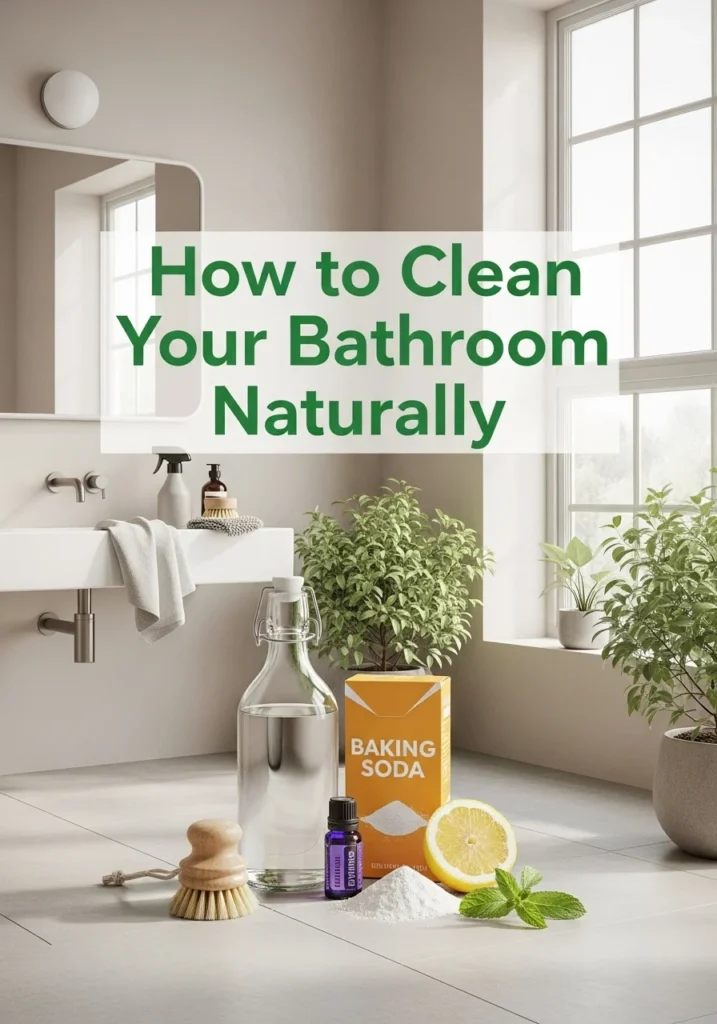
Essential Natural Ingredients for Bathroom Cleaning
When it comes to natural cleaning solutions, the right ingredients are key to achieving an effective, eco-friendly clean without compromising your health or the environment. The beauty of natural cleaning is that you don’t need a long list of specialized products. Instead, everyday ingredients from your kitchen or pantry can handle most bathroom cleaning tasks. Let’s take a closer look at these powerhouse ingredients, their unique benefits, and how they work wonders for your bathroom.
1. Vinegar: The Ultimate All-Purpose Cleaner
Vinegar is one of the most popular and effective natural cleaning agents available. It’s a true powerhouse that can tackle a wide range of bathroom cleaning challenges. As a mild acid, vinegar breaks down mineral deposits, soap scum, and grime, making it ideal for use on bathroom tiles, glass shower doors, sinks, and faucets. Its natural acidic properties also make it an excellent disinfectant, killing a wide range of bacteria, viruses, and fungi that thrive in the humid environment of a bathroom.
In addition to its cleaning prowess, vinegar is also a fantastic deodorizer. It neutralizes odors by breaking down the compounds responsible for bad smells, leaving your bathroom smelling fresh and clean. The best part? Vinegar is non-toxic, biodegradable, and free from the harsh chemicals often found in commercial cleaners.
How to Use:
- Mix equal parts of white vinegar and water in a spray bottle to clean mirrors, countertops, and other surfaces.
- For tough mineral deposits on faucets and showerheads, soak a cloth in vinegar and wrap it around the fixture for a few hours before scrubbing away the build-up.
- Pour vinegar into the toilet bowl, let it sit for a few hours, and scrub to remove stains and disinfect the area.
2. Baking Soda: The Gentle but Mighty Scrubber
Baking soda is a must-have in any eco-friendly cleaning toolkit. Its mild abrasiveness makes it ideal for scrubbing away stubborn stains and soap scum without damaging delicate bathroom surfaces. It can be used on sinks, tubs, showers, and countertops to remove grime and stains, and it’s especially effective on hard water marks and mineral deposits.
Beyond its scrubbing capabilities, baking soda also helps neutralize odors, making it an excellent choice for keeping your bathroom smelling fresh. Plus, it has natural disinfectant properties that can kill germs and bacteria, ensuring that your bathroom is not just clean but hygienic as well.
How to Use:
- Sprinkle baking soda directly onto damp surfaces like sinks or tubs and scrub with a sponge or cloth to remove stains and grime.
- For tougher stains, create a paste by mixing baking soda with water and applying it to problem areas. Let it sit for 10-15 minutes before scrubbing.
- Place an open box of baking soda in your bathroom to absorb lingering odors.
3. Lemon: A Natural Degreaser and Antibacterial Agent
Lemon juice, with its natural acidic properties, is a fantastic option for breaking down grease and grime in your bathroom. It’s particularly effective on soap scum in the shower, where the citric acid can dissolve the buildup with ease. Lemon also has natural antibacterial properties, making it ideal for sanitizing surfaces like sinks, countertops, and toilet seats.
Apart from its cleaning power, lemon adds a fresh, citrusy fragrance to your bathroom. Its refreshing scent can help mask any unpleasant odors, and the high vitamin C content makes it a natural disinfectant. Whether you use it on its own or combine it with other natural ingredients, lemon is an essential part of any eco-friendly cleaning routine.
How to Use:
- Squeeze fresh lemon juice onto a sponge or cloth and use it to wipe down bathroom surfaces, including counters, sinks, and bathtubs.
- Combine lemon juice with baking soda for a powerful cleaning paste that can remove stubborn stains in grout or on tiles.
- Place lemon slices or use a few drops of lemon essential oil in your homemade cleaning solutions for an added fresh scent.
4. Essential Oils: The Aromatic Antimicrobials
Essential oils do more than just make your bathroom smell great. Many of them have natural antimicrobial properties, making them an excellent addition to any cleaning routine. Oils like tea tree oil, lavender oil, and eucalyptus oil are particularly effective in cleaning because of their antibacterial, antifungal, and antiviral qualities. These oils can help eliminate germs and bacteria that thrive in damp, humid spaces like bathrooms.
In addition to their cleaning benefits, essential oils also offer a calming, spa-like atmosphere. Lavender oil, for example, is known for its soothing properties, while eucalyptus oil can help with respiratory health, making it a great choice for use in the bathroom.
How to Use:
- Add a few drops of your favorite essential oil to your cleaning solutions for an extra layer of antimicrobial action and a pleasant scent.
- Create a DIY air freshener by mixing a few drops of essential oils with water in a spray bottle, and spritz it around the bathroom.
- Use essential oils in a diffuser to keep the bathroom smelling fresh and inviting.
5. Castile Soap: A Gentle, Versatile Cleaner
Castile soap is a natural, plant-based soap that is gentle enough for skin and powerful enough for cleaning. Made from olive oil, it’s biodegradable, non-toxic, and free from harmful chemicals found in conventional cleaning products. Castile soap can be used on nearly every surface in your bathroom, from the sink to the shower, and even as a mild shampoo or body wash.
Its gentle formula makes it ideal for cleaning sensitive surfaces like natural stone countertops or delicate ceramic tiles. It also lathers well, which makes it easy to apply to surfaces and remove dirt or grime without leaving streaks behind.
How to Use:
- Mix a few drops of castile soap with water in a spray bottle for an all-purpose cleaner that can be used on countertops, mirrors, and sinks.
- Use a diluted solution of castile soap and water to clean glass shower doors and windows, leaving them streak-free.
- Add a small amount of castile soap to a mop bucket when cleaning your bathroom floor for a deep clean.
6. Hydrogen Peroxide: A Potent Disinfectant
Hydrogen peroxide is often overlooked as a cleaning agent, but it’s one of the most effective natural disinfectants available. Its ability to break down organic matter makes it a powerful tool for killing germs, bacteria, and fungi in the bathroom. It’s particularly useful for disinfecting toilet bowls, sinks, and even showerheads. Hydrogen peroxide can also be used to remove stubborn stains from grout and tile, helping to brighten your bathroom surfaces.
One of the great advantages of hydrogen peroxide is that it breaks down into water and oxygen, making it safe for both your health and the environment.
How to Use:
- Spray hydrogen peroxide directly onto bathroom surfaces like countertops, sinks, and faucets to disinfect and remove stains.
- Pour hydrogen peroxide into the toilet bowl, let it sit for 10-15 minutes, and scrub to remove stains and disinfect the area.
- Use hydrogen peroxide to spot-clean grout or tile by spraying it directly onto the stained areas and letting it sit before scrubbing.
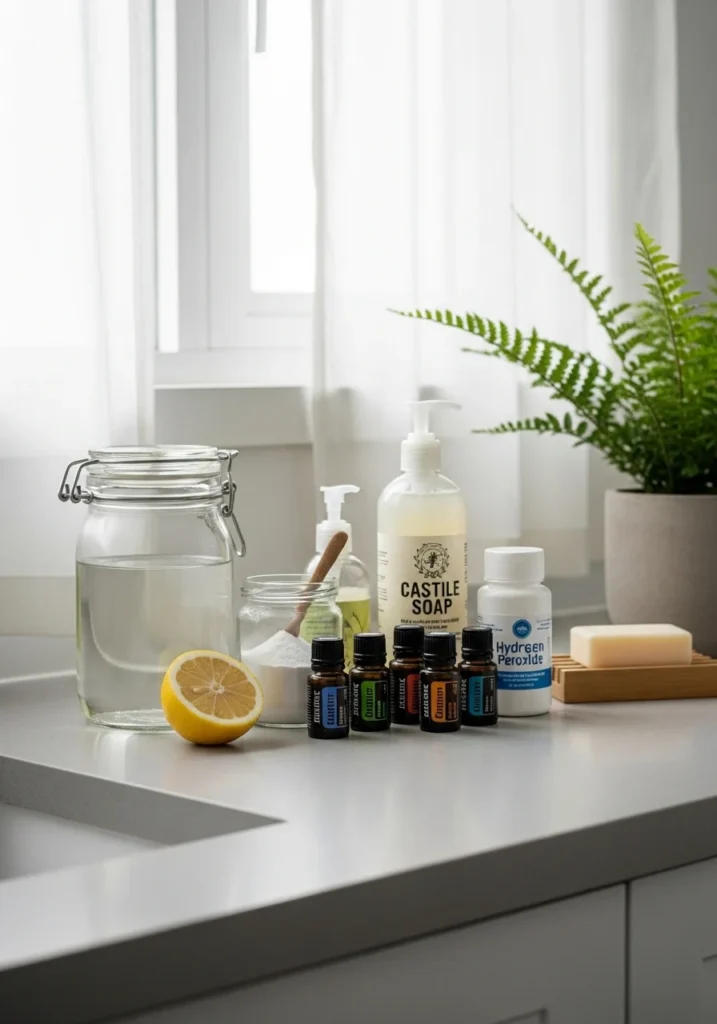
CLEANING TIPS FOR BATHROOM
Cleaning your bathroom with natural ingredients doesn’t have to be time-consuming or complicated. Armed with simple, eco-friendly ingredients, you can achieve a sparkling clean bathroom that’s free from toxic chemicals. In this step-by-step guide, we’ll walk you through the process of cleaning each area of your bathroom, from the sink to the floors, using safe, effective, and affordable natural cleaning solutions.
Preparation: Gather Your Supplies
Before diving into the cleaning process, it’s essential to gather all the ingredients and tools you’ll need. You don’t need an entire shelf full of expensive cleaning products—just a few key natural ingredients and basic cleaning tools will do the trick.
Here’s a checklist of what you’ll need:
- Vinegar (white vinegar works best)
- Baking soda
- Lemon (or lemon juice)
- Essential oils (such as tea tree oil, lavender, or eucalyptus)
- Castile soap
- Hydrogen peroxide
- Microfiber cloths (gentle yet effective for wiping and polishing)
- Scrubbing brush (for tougher stains)
- Mop (for the floors)
- Spray bottles (for easy application of cleaning solutions)
- Toilet brush (for cleaning the toilet bowl)
- Bucket (optional, for floor cleaning solutions)
With everything on hand, you’re ready to clean.
Cleaning the Sink and Countertops
Your bathroom sink and countertops accumulate soap scum, toothpaste, and water spots, making them a prime target for daily cleaning. The combination of vinegar and baking soda is incredibly effective at removing soap scum and other buildups, leaving your surfaces sparkling.
- Sprinkle Baking Soda Over Surfaces:
- Begin by sprinkling baking soda generously over your sink and countertops. Baking soda acts as a mild abrasive, which helps scrub away dirt and stains without damaging the surfaces.
- Spray with Vinegar:
- Next, spray vinegar over the baking soda. The vinegar will react with the baking soda, causing it to fizz and bubble. This reaction helps break down grime, soap scum, and stubborn stains. Let it sit for 3-5 minutes.
- Scrub and Wipe Away:
- Using a microfiber cloth or a scrubbing brush, gently scrub the surfaces in circular motions. Focus on areas with more grime or buildup. Once you’ve scrubbed the surfaces clean, wipe away the residue with a damp cloth. You’ll be left with a spotless sink and countertop.
- Toothpaste Stains:
- Toothpaste can leave stubborn stains on the sink and countertop. To tackle this, create a paste by mixing baking soda and water. Apply the paste directly to the stain and allow it to sit for 10-15 minutes. Scrub with a brush or sponge and rinse away the stain. The mildly abrasive nature of baking soda will remove the toothpaste without scratching the surface.
Cleaning the Toilet
The toilet is one of the most crucial areas to clean, but fortunately, natural ingredients can make the task easy and effective.
- Natural Toilet Bowl Cleaner:
- Start by pouring 1 cup of baking soda into the toilet bowl. Follow it up with 1 cup of vinegar. Let the mixture sit in the toilet bowl for 10-15 minutes. The reaction between the baking soda and vinegar will help break down mineral deposits, stains, and bacteria. If you want to add an extra layer of disinfection, drop a few drops of tea tree oil into the bowl for its antibacterial and antifungal properties.
- Scrub the Bowl:
- After letting the mixture sit, use a toilet brush to scrub the inside of the toilet bowl, focusing on stains, mineral buildup, and around the rim. The natural abrasiveness of the baking soda will scrub away dirt and grime without damaging the porcelain.
- Toilet Tank and Lid:
- For the exterior of the toilet, particularly the toilet tank and lid, use a vinegar and water solution. Mix equal parts vinegar and water in a spray bottle. Spray the solution generously on the surfaces and wipe them down with a clean microfiber cloth. The vinegar will dissolve mineral deposits and eliminate germs.
Shower and Bathtub
The shower and bathtub are often the most difficult to clean due to the accumulation of soap scum, mildew, and mold. Fortunately, natural solutions like vinegar, baking soda, and hydrogen peroxide can make the job much easier and safer.
- Mold and Mildew Removal:
- For mold and mildew that tends to grow in damp areas, create a solution by mixing 1 part vinegar with 1 part water in a spray bottle. Spray it generously on affected areas like grout lines, shower curtains, and tiles. Allow the solution to sit for 10-15 minutes. After the wait, use a scrubbing brush to scrub away the mold and mildew. Rinse thoroughly with water.
- DIY Tile Cleaner:
- For cleaning tiles and grout, mix 1 cup of baking soda with 1/2 cup of water to create a thick paste. Apply the paste directly onto the tiles and grout, and scrub it with a brush. Focus on grout lines, as they tend to accumulate grime. After scrubbing, rinse with warm water, and your tiles will shine!
Floors
Bathroom floors often collect hair, dirt, and grime. An easy, natural floor cleaner made with vinegar and water will leave your bathroom floors looking pristine.
- Natural Floor Cleaner:
- Mix 1/2 cup of vinegar with a gallon of warm water in a bucket or mop bucket. If you prefer a more pleasant fragrance, add a few drops of essential oils such as lavender, eucalyptus, or tea tree oil. The vinegar acts as a powerful cleanser, while the essential oils add a fresh, natural scent.
- Mop the Floor:
- Dip your mop into the cleaning solution and wring out the excess liquid. Mop your bathroom floor, paying extra attention to corners and areas that tend to accumulate dirt. The vinegar will disinfect the surface while the essential oils will provide a fresh, pleasant aroma.
Finishing Touches
Once all surfaces are cleaned, it’s time to add the final touches:
- Polish Mirrors and Glass: Spray a mixture of equal parts vinegar and water onto your bathroom mirrors and glass shower doors. Wipe with a clean microfiber cloth for a streak-free shine.
- Disinfect Door Handles and Light Switches: Don’t forget to disinfect high-touch areas like door handles, light switches, and faucet handles. Use your vinegar and water solution to wipe down these surfaces.
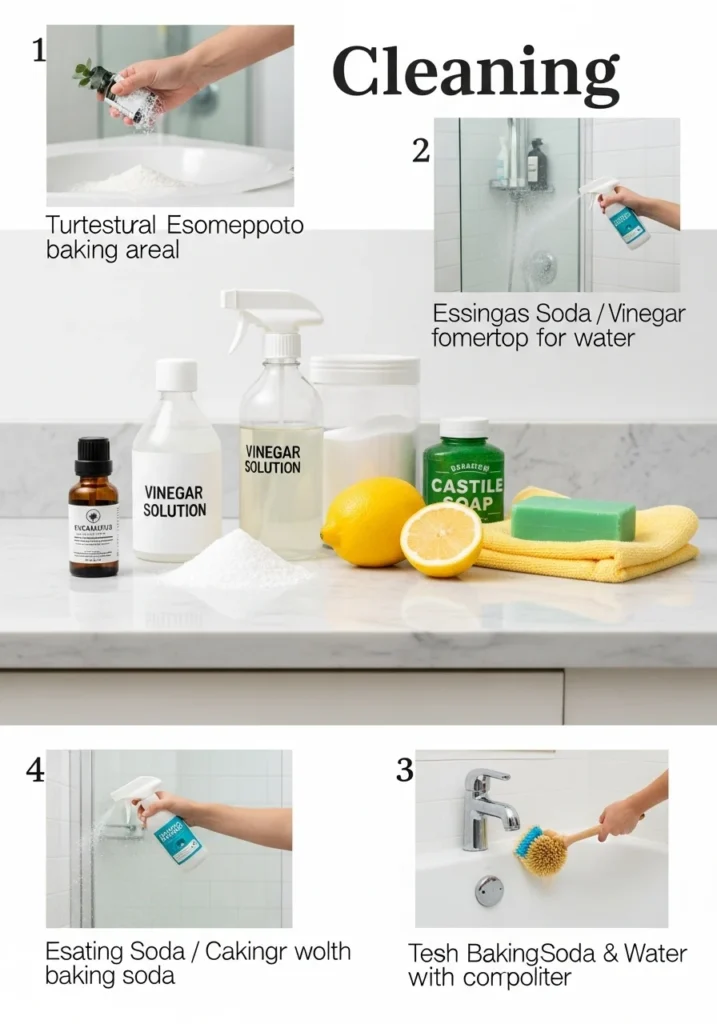
Eco-Friendly Tips for Long-Term Bathroom Cleanliness
Achieving a clean and fresh bathroom using natural methods is a great start—but maintaining that cleanliness over time is equally important. A bathroom is a high-humidity, high-use space that easily becomes a breeding ground for bacteria, mold, and mildew. Fortunately, with a few sustainable habits and preventative measures, you can keep your bathroom sparkling clean while minimizing your environmental footprint. These long-term eco-friendly tips not only extend the results of your deep cleaning efforts but also help you build a healthier home.
1. Prevent Mold and Mildew Naturally
Mold and mildew thrive in moist, poorly ventilated environments—making the bathroom one of their favorite places to grow. However, you can significantly reduce the chances of mold formation by implementing a few simple preventative practices.
Improve Ventilation
One of the most effective ways to keep mold at bay is to maintain proper airflow in your bathroom. Always keep a window open during and after showers if possible, or use an exhaust fan to remove moisture from the air. If your bathroom lacks good ventilation, consider placing a small dehumidifier in the room to help reduce humidity levels.
Wipe Down Wet Surfaces
After every shower or bath, use a microfiber cloth or squeegee to wipe down the tiles, shower walls, glass doors, and sink areas. This simple step only takes a minute but drastically reduces moisture buildup, which helps prevent mildew from forming on surfaces.
Natural Mold Prevention Spray
Create a natural anti-mold spray using a mix of water, white vinegar, and a few drops of tea tree oil or eucalyptus oil. These essential oils are known for their antifungal properties. Spray this solution on shower walls, tiles, and corners every few days to discourage mold from taking hold.
2. Use Natural Air Fresheners
Many commercial air fresheners contain synthetic fragrances and chemicals that can irritate your respiratory system and degrade indoor air quality. Fortunately, there are natural alternatives that are just as effective and much safer for your health and the planet.
Essential Oils for a Fresh Scent
Place a few drops of your favorite essential oil (like lavender, lemon, peppermint, or eucalyptus) on a cotton ball and place it behind the toilet, on a shelf, or in a corner. As the oil evaporates, it will release a pleasant aroma throughout the bathroom. You can also make a DIY spray by mixing water with a few drops of essential oil in a small spray bottle—perfect for refreshing the air after each use.
Baking Soda Deodorizers
Baking soda is a natural odor neutralizer. Place an open container or small dish of baking soda on a shelf or under the sink to absorb unpleasant odors. For a fragrant twist, mix a few drops of essential oil into the baking soda and stir it every few days to reactivate the scent.
Herbal Sachets and Dried Flowers
Place herbal sachets filled with dried lavender, rosemary, or chamomile in drawers or behind the toilet. Not only do they add a natural fragrance, but they also give your bathroom a clean and cozy feel.
3. Maintain a Clutter-Free Bathroom
A clean, organized space is easier to maintain and clean. When your bathroom is cluttered with toiletries, towels, and miscellaneous items, it can quickly become chaotic, creating more surfaces for dust, spills, and germs to accumulate. Keeping your space tidy supports both visual cleanliness and actual hygiene.
Simplify and Declutter Regularly
Periodically go through your toiletries and discard expired products, empty containers, and items you no longer use. Donate unopened, unused products to local shelters if you no longer need them. The fewer products you have on display, the easier it is to clean your counters and shelves quickly.
Use Natural Storage Solutions
Opt for sustainable, natural materials such as bamboo baskets, cotton rope bins, or wooden trays to organize your bathroom items. Store items like towels, toilet paper, and cleaning supplies in these containers to reduce visual clutter while keeping everything easily accessible.
Designate Spaces for Essentials
Assign specific areas for daily-use items and store infrequently used products out of sight. For instance, use small labeled jars or glass containers for things like cotton balls, toothbrushes, and hair ties. This not only looks aesthetically pleasing but also prevents messes from spreading across your bathroom surfaces.
Towel Management
Keep a designated area for used towels—a hamper or hook system works great to keep damp towels from piling up on the floor or counters. Also, replace towels regularly to maintain freshness and prevent musty odors.
4. Adopt a Quick Daily Cleaning Routine
A few minutes each day can go a long way in preserving bathroom cleanliness. Instead of waiting for messes to build up, adopt a short daily routine that keeps things fresh with minimal effort.
Daily Tasks to Maintain Cleanliness:
- Wipe down the sink and countertops after brushing your teeth or washing your face.
- Use a microfiber cloth to quickly clean the mirror if you notice smudges.
- Keep a natural cleaning spray (vinegar + water + essential oil) under the sink for quick spritz-and-wipe jobs.
- Give the toilet a quick brush every couple of days—even if it doesn’t look dirty—to prevent stains from setting.
- Shake out bath mats and towels and hang them properly to air out.
These quick touch-ups make deep cleaning less frequent and far less intensive.
5. Use Eco-Friendly Tools and Accessories
Sustainable cleaning doesn’t stop at ingredients—it extends to the tools you use as well. Switching to eco-friendly cleaning tools reduces waste and supports a more sustainable lifestyle.
Reusable Cleaning Cloths
Replace disposable paper towels with microfiber or cotton cleaning cloths that can be washed and reused. These are gentle on surfaces, highly absorbent, and reduce landfill waste.
Sustainable Scrub Brushes
Opt for bamboo or wooden scrub brushes with natural bristles instead of plastic ones. They’re biodegradable and just as effective for scrubbing sinks, tubs, and tiles.
Natural Sponges
Use plant-based or compostable sponges for scrubbing tasks. These are free from synthetic dyes and materials and break down more easily in the environment when disposed of.
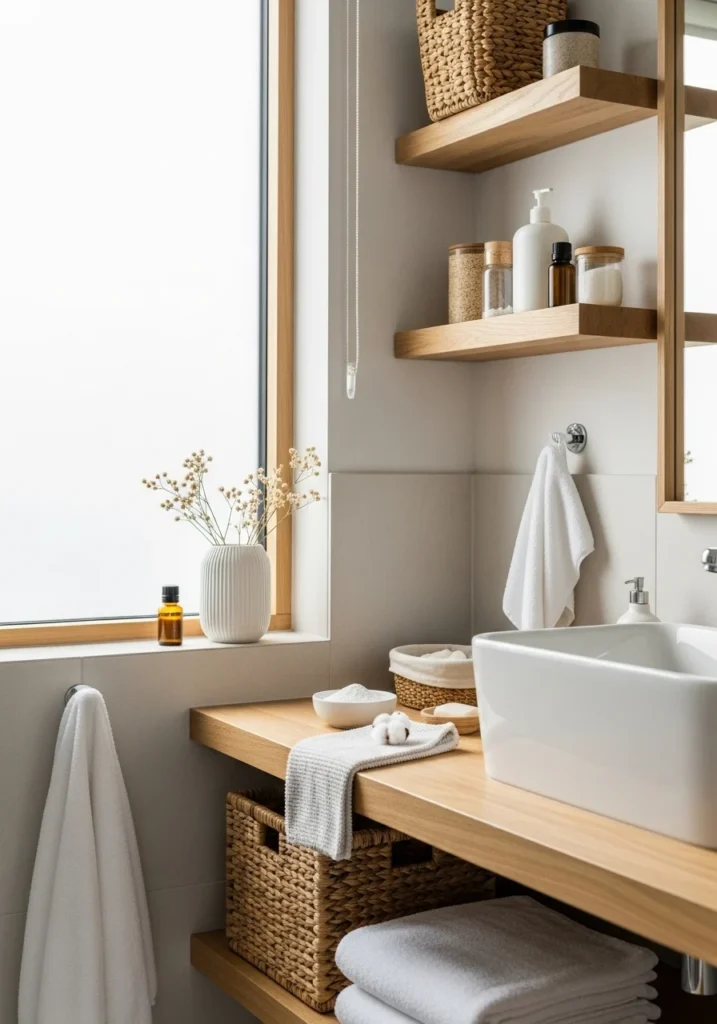
Conclusion
Cleaning your bathroom naturally is more than just a trend—it’s a shift toward a healthier, safer, and more environmentally conscious lifestyle. Many traditional bathroom cleaning products are loaded with harsh chemicals that can harm both your health and the planet. These chemicals can irritate your skin, damage surfaces, and contribute to poor indoor air quality. By making the switch to natural cleaning methods, you’re not only safeguarding your well-being but also reducing your environmental impact and creating a more sustainable home.
Why Natural Cleaning Matters
Using natural ingredients like vinegar, baking soda, lemon, and essential oils to clean your bathroom is a simple yet effective way to create a healthier home. These everyday items are powerful, non-toxic alternatives to store-bought products that often contain dangerous chemicals such as ammonia, chlorine bleach, and phthalates. These toxic substances can irritate your skin, eyes, and lungs and are harmful to children and pets who may come into contact with them. With natural cleaners, you eliminate those risks entirely while still achieving the same (if not better) cleaning results.
Beyond personal health benefits, natural cleaning methods also promote environmental sustainability. Conventional cleaning products often come in plastic bottles that end up in landfills, contributing to waste. Additionally, the chemicals in these products can leak into waterways and soil, polluting the environment and harming wildlife. By opting for eco-friendly solutions, such as reusable microfiber cloths and ingredients that can be found in most households, you’re helping reduce waste and your carbon footprint.
Affordability and Accessibility
One of the major advantages of using natural cleaning methods is their affordability. Many of the ingredients you need—vinegar, baking soda, lemon, and essential oils—are relatively inexpensive and can be found in most grocery stores. In contrast, commercial cleaning products can cost anywhere from $5 to $20 per bottle, especially when buying specialized cleaners for specific areas like tile grout, mirrors, and toilets.
Not only are natural ingredients more affordable, but they’re also multi-purpose. For example, vinegar works as a disinfectant, deodorizer, and grease cutter, while baking soda can be used for scrubbing, deodorizing, and even stain removal. This means that you can invest in a few staple items and use them for a variety of cleaning tasks—making your cleaning routine simpler and more cost-effective.
Transform Your Bathroom into a Cleaner, Greener Sanctuary
By making the switch to natural cleaning, you’re not only enhancing the cleanliness of your bathroom but also turning it into a sanctuary of health, comfort, and eco-conscious living. Whether you’re cleaning your sink, toilet, shower, or floors, natural ingredients can tackle every area without the need for harsh, chemical-laden products. Plus, you get to enjoy the added bonus of fresh scents from essential oils, which are both naturally antimicrobial and beautifully fragrant, enhancing the overall ambiance of your bathroom.
Beyond cleaning, these practices help transform your bathroom into a more mindful space. By incorporating natural elements and sustainable products, you create a bathroom that reflects your values—values of sustainability, simplicity, and well-being. This shift in how you clean and maintain your home can also influence other areas of your life, helping you make more eco-friendly choices in everything from personal care products to home deco
